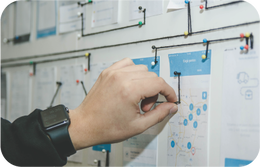What is Ethnographic Research?
Ethnographic Research means observing users in their natural environment to better understand motivations, attitudes, and behaviors.
Typical method includes observation along with a semi-structured interview to obtain information about the context of use in the user's own environment. Ethnographic Research differs from standard interviews by allowing the interviewee to share artifacts of the environment and to demonstrate processes with tools on hand.
Through the process of demonstration, this method allows participants to be "in the moment" and to recall things in a more meaningful way.
Typical method includes observation along with a semi-structured interview to obtain information about the context of use in the user's own environment. Ethnographic Research differs from standard interviews by allowing the interviewee to share artifacts of the environment and to demonstrate processes with tools on hand.
Through the process of demonstration, this method allows participants to be "in the moment" and to recall things in a more meaningful way.
Why do Ethnographic Research?
|
To design effective experiences we need to know specifically who we're building for and what they do.
|
Site visits, observations and interviews help us to understand real people, in real settings, doing real work.
|
In addition to capturing user behaviors, ethnographic research helps us see the motivations behind the behaviors.
|
Find out more about ethnographic research at End to End by exploring our case studies.




